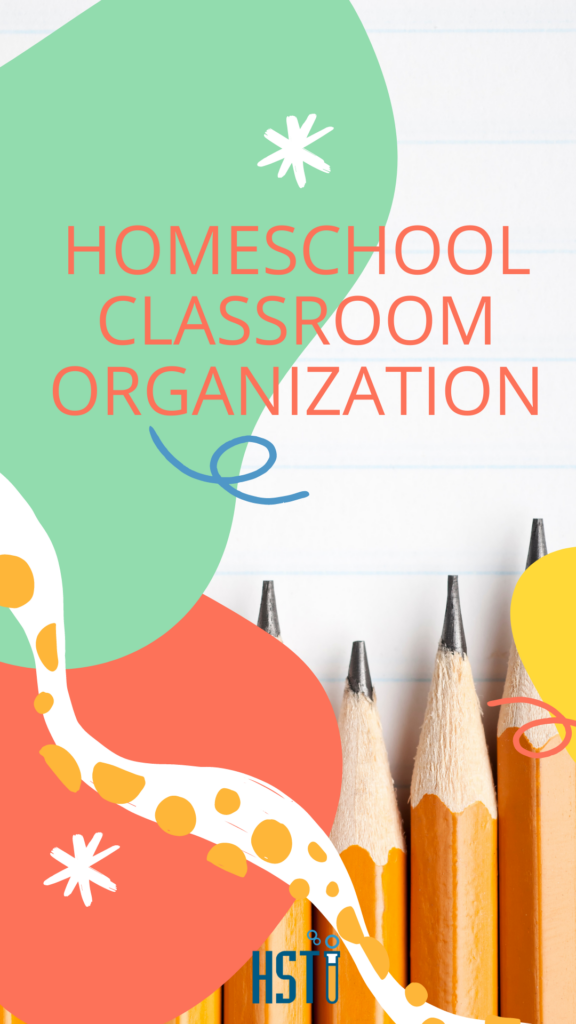Do you have a dedicated learning area set up for a homeschool classroom? Many families don’t and find that not having dedicated space makes them less productive. However, homeschool families that do have a dedicated space know that it offers its own set of challenges. There are pros and cons to both scenarios and ultimately, you’ll have to decide what’s best for your homeschool student.
Starting a new school year is always fun and exciting!! And setting up your homeschool classroom is part of the fun. The most important thing to remember is that there is no one right way to do it.

Ideas for Homeschool Room Organization
Whether your homeschool classroom space is large or small, is fully decked out with furniture or not, you can find all kinds of designs to inspire you on Pinterest when you search there, so don’t worry if you need ideas! If you are a homeschool family that does better with a dedicated space or has a room that you can call your ‘schoolroom’ then you’re more likely to be able to get tables and bookshelves dedicated to your homeschool space. When I started out as a homeschool mom, our dedicated space was our kitchen table. I had enough room in the kitchen for one bookcase and that’s where we kept all of our school supplies. I can’t say that I loved it, but it was what we had at the time and it worked.
If you have a larger space or an entire room where you can do school, then you might want to explore setting up your room in a way that is conducive to having different areas dedicated to different tasks. You might have a large table for doing big projects or art, you might have a corner with bean bags that is your reading nook, or maybe your kids are into building Legos and you have a corner with a table dedicated to that where there can be ongoing thinking and designing happening.
Whatever the size of your room, there are a couple of key design elements that will make having a dedicated school space easier.
- Desk. As I mentioned, we did homeschool at our kitchen table. My kitchen table was our desk. We used it for day-to-day schoolwork, as well as any projects we did. We had a plastic table cloth that I had purchased at a yard sale that we pulled out every time we got into a messy project. A large table works best and can double as your group learning table, as well as your project table. Whatever kind of table you end up with, make sure that it has a smooth writing surface. Also, chairs, although are wanted at times, were usually pushed back at our house. My kids would often think best when they were standing and slightly in motion. Don’t be afraid to think outside the box for ‘sitting’.
- Bookshelf. What I would have given for multiple bookshelves! We had one that had five shelves. Those five shelves were packed to the rim with our homeschool supplies. I didn’t have any space for a rolly cart or any kind of moveable organizer. We had Rubbermaid boxes with our stuff organized that way. One for pens, pencils, sharpies, one for crayons and markers, one for craft supplies, one for science kits, you get the idea. Our one shelving was overused for sure, but it was a lifesaver for our small space. Many times, you can find used bookshelves at yard sales, but of course, you can find some great ones on Amazon or at Ikea, as well.
- Whiteboards. – If you have a visual learner, a whiteboard can be a great investment! Of course, if you have a small space you might not have the wall space for a whiteboard. I didn’t, so the way I solved the problem is by buying small, individual whiteboards. My kids used them to practice writing, practice math, and draw in their free time. They really were something we used almost daily. Of course, if you do have the wall space for a large board, you can get the ones that are magnetic and those are handy at times, too. (I even know a family who even had an old-fashioned chalkboard in their room!)
- Bulletin board. This is a helpful addition to your classroom if you can manage it. Again, you’ll have to have the wall space for it, but it is helpful for keeping reminders, loose schoolwork that you may be working on, a calendar, etc all in one place.
- School supplies. Of course, this one seems like a no-brainer. You’ll need pens, pencils, and paper/notebooks, however, you may not need much beyond that. Although my kids always enjoyed going school supply shopping, I found that we needed less and less as they got older. Depending on the type of homeschool curriculum you purchased, it would often dictate what supplies you would need, so figure that out first. One supply that you’ll want to be sure to get for yourself is a homeschool planner. There are loads of varieties out there, and whether you get a free printable one or you purchase one that fits you and your family, you’ll want one as a way to help you plan your school year.
- Homeschool curriculum. Choosing a homeschool curriculum can cause many homeschool parents stress. There are so many options, it can seem overwhelming. Know your child’s learning style and lean on that for the type of curriculum you choose. Of course, choosing hands-on is always fun, and science can be a great place to start for science kits.
What if you aren’t the type to have a homeschool classroom?
What kind of homeschooler are you? My friend dreamed of having a devoted schoolroom. But in her nineteen years of homeschooling, she just couldn’t bring herself to it, even though she tried. More than once! She fixed up the basement and turned it into a beautiful learning environment. In two different houses. Here’s what she discovered and shared with me: I am a kitchen table homeschooler. While my kids are working and learning, I love to be able to do the dishes, fold the laundry, or empty the dishwasher. Along those lines, my oldest child learned basic cooking and kitchen skills because I had her make lunch while I read aloud to everyone. I’ve even handed Magic Erasers to my kids and had them scrub the cabinets and woodwork while I read. For me, being in an isolated workspace made this difficult. Plus, our basements didn’t have windows. The lack of light was a problem.
Many unschoolers take their learning on the go, too, and don’t have a dedicated learning space. You’ll need to decide what kind of homeschooling family you have and make concessions for learning the way your homeschool students learn best. A homeschool classroom isn’t for every homeschool family.
Final thoughts for setting up your homeschool room.
Use what you have. Our dining room space worked for homeschooling. It tended to look much more like a schooling area than a formal dining room, and I was never embarrassed by the bookshelf that held all of our things. Find the space you have that can accommodate your “school tools” and use it! It may be a room. It may be a corner. You can make anything work. Two of our homes had 80-s era full-wall mirrors. (I know you’re jealous!) So I bought dry-erase markers designed for the glass, and that space became our whiteboard. I could utilize it to write assignments, leave messages for family members, or detail chore charts. The kids also loved using it to work on math problems and diagramming sentences.
Use individual storage spots when you don’t have dedicated storage space. It’s helpful for each student to have space for their books, cubbies so to speak, and you’ll need a space to keep planners and teacher resources. One year, my friend gave each of her kids a milk crate. They were expected to keep their books organized and handy in that crate. They could also carry it wherever they did school — outside, their rooms, the living room, or the front porch.
There’s no magic to what you use, but it’s helpful if each child has a spot. One more tip: Kids are generally skilled at “losing” their school books. My rule — if I find it before you do, you owe me a dollar. This usually brought the missing items to light quickly.
Be flexible! One of the beauties of homeschooling is flexibility! What works one year may not work the next. What works for your friends’ kids may not work for you. Don’t be afraid to change what isn’t working! I had years where my kids fought about the space they had at the dining room table, or about how their brother was shaking the table when he erased on his paper. You may need to put one kid at a coffee table, another at the dining room table, and another at the dining table, or even on the floor. Do what works for YOU in your current situation.
Have fun! This is most important. Enjoy this time. Enjoy your kids. Enjoy this opportunity. Change it up sometimes. Incorporate special days — Super Hero Day. Backward Day. School Outside Day. Everything is Red Day. Do what works to keep the doldrums away. We always started the year with fun school supplies. Keep things fresh. Smile with them. And sprinkle your days with laughter.






